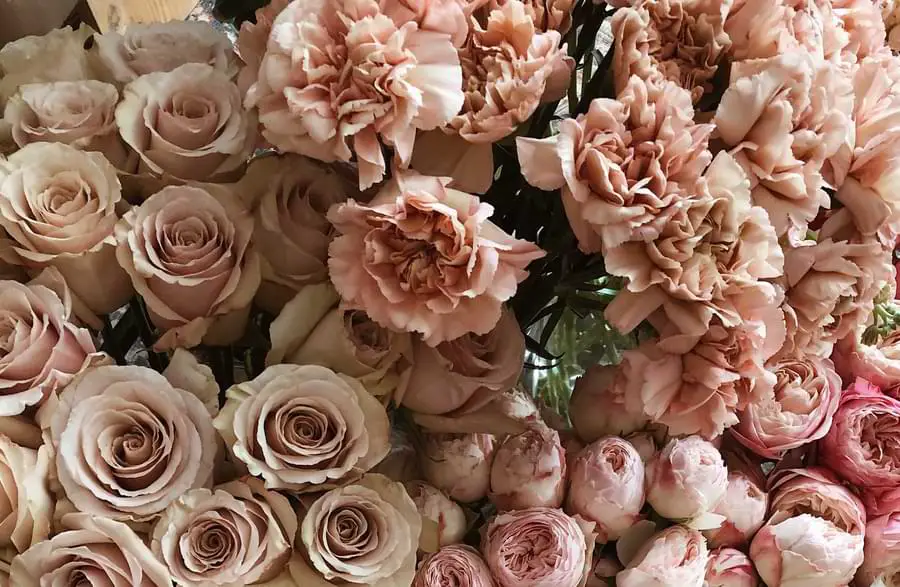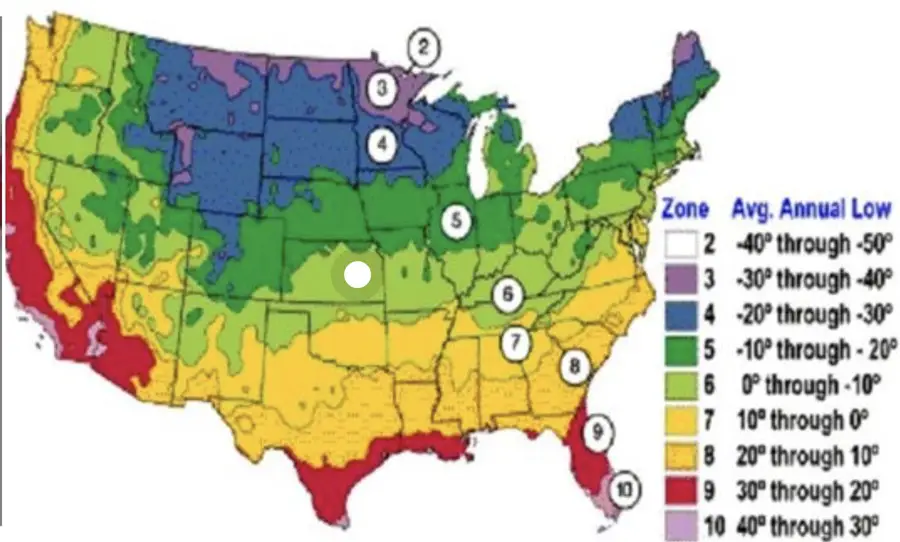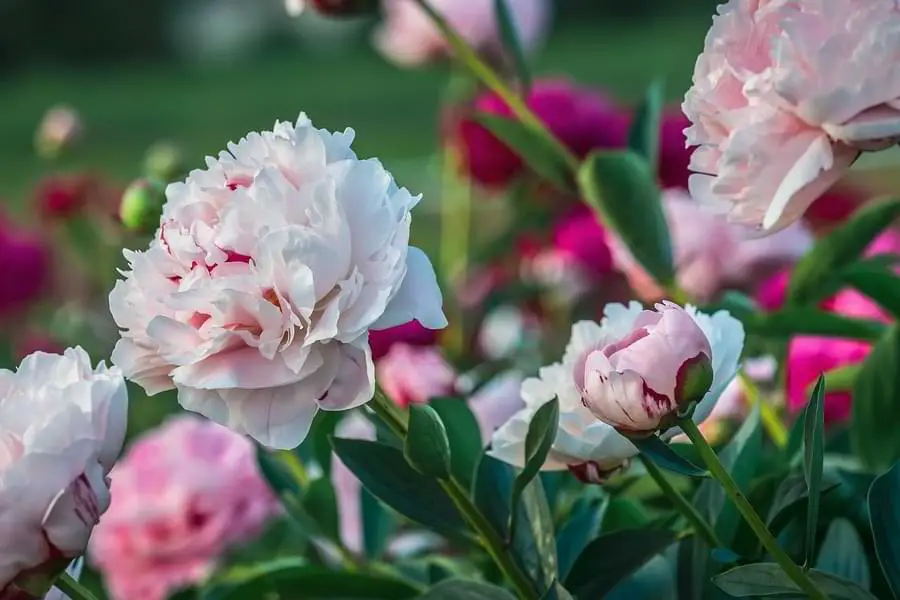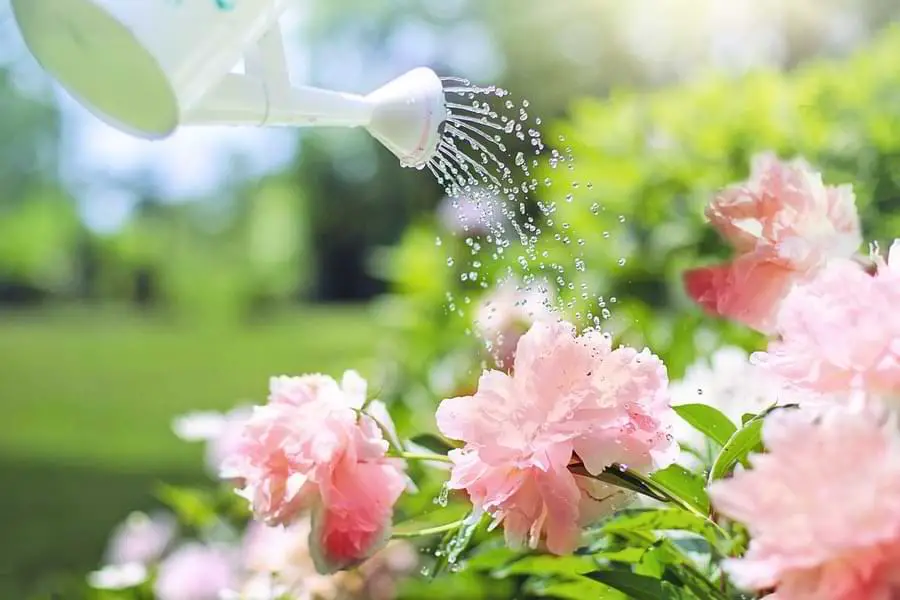Looking to plant roses and peonies together? Well, peonies are the symbol of romanticism and unconditional love …and the same goes for roses. So both of these plants make a perfect romantic pair together. However, are roses and peonies good companion plants? How do they fare as companions when it comes to their daily needs and other aspects?
Let’s have a look at some of their common similarities and differences. Plus I’ll highlight their differing needs, which despite these, still make them ideal to be planted together.
First, we’ll start with the short answer, then we’ll get into more details…
Roses and peonies work well together. They have similar soil, pH value, and sun requirements. Their height, color options, and blooming periods match well together. Peonies attract pollinators to roses but do not deter aphids and other pests. They also need less frequent watering than roses.
That’s the summary, but there are other aspects, and some help that we can offer here too, so read on for more rose and peonies companion details.
Are roses and peonies good companion plants
So are roses and peonies good companion plants? Let’s go through the general criteria for roses and peonies. But I’ll also add a quick reference table here too.
| Rose | Peony | |
|---|---|---|
| Growing zones | Ideally 7 – 10 | 3 – 9 |
| Color | Red, Pink, White, Yellow, Orange, Blue, Purple, and color mixes | Pink, Red, Yellow, Orange, and White. Purple and Blue are also available |
| Height | Depends on variety. Generally 2 – 5 feet | 1 – 3 feet |
| Blooming period | Early spring to mid/late summer | Late spring to early summer |
| Soil | Loamy, well-drained | Loamy, well-drained |
| pH Value | 6.5 to 7.0 | 6.5 to 7.0 |
| Sun | 6+ hours of sun | 6 – 8 hours of sun |
| Water Needs | 1 – 2 inches, every 3 – 4 days | Deep watering every 10 – 14 days |
| Pollination and Pests | Minimal pollinators. Attracts aphids | Attracts pollinators |

Growing zones
Initially, let’s just make sure we can grow roses and peonies in the same kind of USDA zone. And similar applies to other regions and countries. More on that later.

Peonies are happy to grow in zones 3 to 9. They are intolerant to frosts and in winters they die or go dormant, the petals and leaves start to deteriorate, and the plant falls to the ground.
That is why peonies are not ideal to grow at the extremes of the USDA hardiness zone chart.
Roses share the same climate requirements with the peonies of zone 7, 8, and 9 mostly. There are a lot of peonies species found in these zones that can be easily planted with roses. So that’s a big plus for starting a rose and peony flower bed.
For example:
Chinese peony found in zone 3-7 is paired with roses in zone 7 and some that are hardy in zones 3 and upward. Similarly, the Delavayi tree peony found in zones 5 to 9 is paired in zone 7-9 with roses.
Color options
Peonies look stunning alongside roses in the garden and come with a variety of vibrant love-vibe colors. They are mostly available in pink, red, yellow, orange, and white shades.
Apart from these, peonies are also available in purple and blue colors …these are quite rare but worth searching for species to add to the other colors in your garden.
When planted beside roses, peonies can be contrasted with the variety of rose colors already available.
The pink and white rose-peony is so well known that both of them are frequently used in bridal bouquets at weddings and receptions.

Peony blooming period
So when do peonies bloom?
Generally speaking, peonies will bloom from late spring and continue through to early summer. By planting a combination of varieties you can get a consistent bloom between late spring and mid to late summer.
Roses and peonies have a similar blooming period, roses also bloom from early to mid-spring through to mid to late summer. Some repeat bloom too throughout this period.
Of course, which months roses bloom for is influenced somewhat by which city, state, or country you’re in.
Here’s an example of one of the most popular peonies. These are also ideal to grow alongside roses.
Kansas peonie

The Kansas Peony is easy to grow and can be grown in most growing zones from 3 – 8. They are a vibrant red, they like full sun, and loamy soil.
They generally grow to around 2 – 3 feet and can be pruned in late Fall, so similar times to your rose pruning diary dates.
Check availability of Kansas Peony (Paeonia lactiflora) ‘Kansas’
Comparable heights
Peonies range from 1 to 3 feet in height and space depending upon the variety and conditions of the soil.
The stalk of the flowers is quite delicate and can be bowed when loaded with blooms. So it is good to provide some support for them to stand upright.
Combined with rose which, aside from climbers and rambling roses grow around 3-5 feet in height generally, they can make an exquisite-looking pair …that meet a lot of pairing criteria to elevate the ornamental flamboyance of your flower bed.
Soil and Sun
Peonies have largely the same soil and sun conditions as roses. So peonies make ideal partners for roses in full sun flower beds.
Peonies love to bloom in well-drained soil with a pH value of about 6.5 to 7, which is exactly the same as roses. Not only this but roses prefer loam soil to grow and peonies prefer this too.
For sun and shade, peonies perform best in full sun for 6 to 8 hours daily and can tolerate a partially shady area once the need for adequate sunlight is full-filled.
Similarly, roses love the direct sun for at least 6 hours a day. They can survive a slight shade as well as a little bit of acidic soil, but their growth and blooms may not be as optimized.

Water needs
Roses like regular watering. Normally they will need watering around 1 – 2 inches, every 3 – 4 days. This can be altered based on how dry the conditions are. Peonies on the other hand are watered in a different way.
Peonies need a deep watering around 10 – 14 days. However, in hot weather, they will need more regular watering. You will know if you are not watering peonies enough if they appear to be wilting, dry and/or dry foliage, and drooping and discolored buds.
Peonies that are newly planted roots will need to become established, so require nourishing. Also, they will need more regular watering than established peonies. So aim to water them deeply once a week. This should be increased to every 3 – 4 days in dry conditions.

Pollinators and Pests
Peonies when paired with roses, increase the pollination opportunities of roses along with them. This is because peonies secrete sweet extra-floral nectar. This means that the nectar is present on the outside of the buds.
This is very attractive to bees and ants. Thus you will see a lot of bees, butterflies, and ants on your rose and peonies pairing.
Generally speaking, roses can struggle to attract bees and butterflies.
These insects are generally non-damaging to the plants. Bees and butterflies in particular will mainly just aid in pollination without causing any diseases or rotting in the plant stems.
Ants seem to be very attracted to peonies, And ants will of course likely be present on your roses if aphids are around.
Roses and Peonies together ~ More roses help 🌹
I hope this has helped to provide some understanding of planting roses and peonies together as companion plants.
Overall, roses and peonies make good flower bed companions. So go ahead and enjoy both of these plants in your garden.
Be sure to check out my related articles below. And also check my tools and resources page.

Hi, I’m Michael. My passion for roses was sparked a few years ago after visiting a dedicated community rose garden. So Rosehow.com represents my take, my learnings, and my help for anyone looking to grow, be proud of, and harvest roses.

